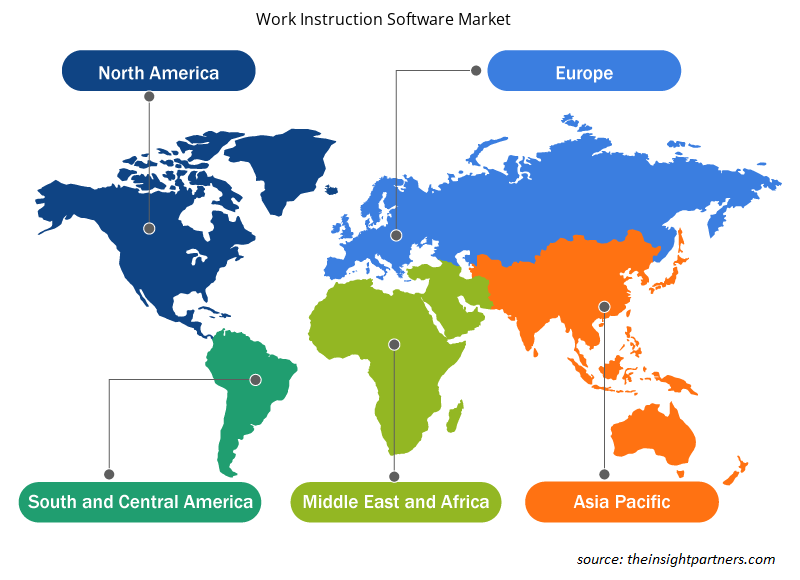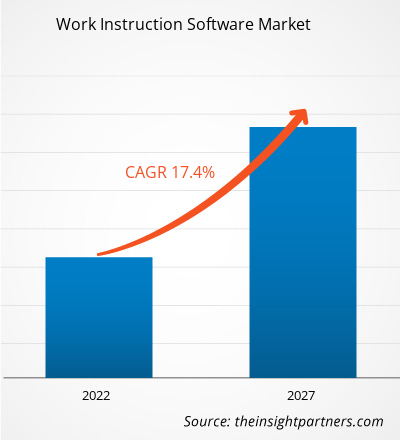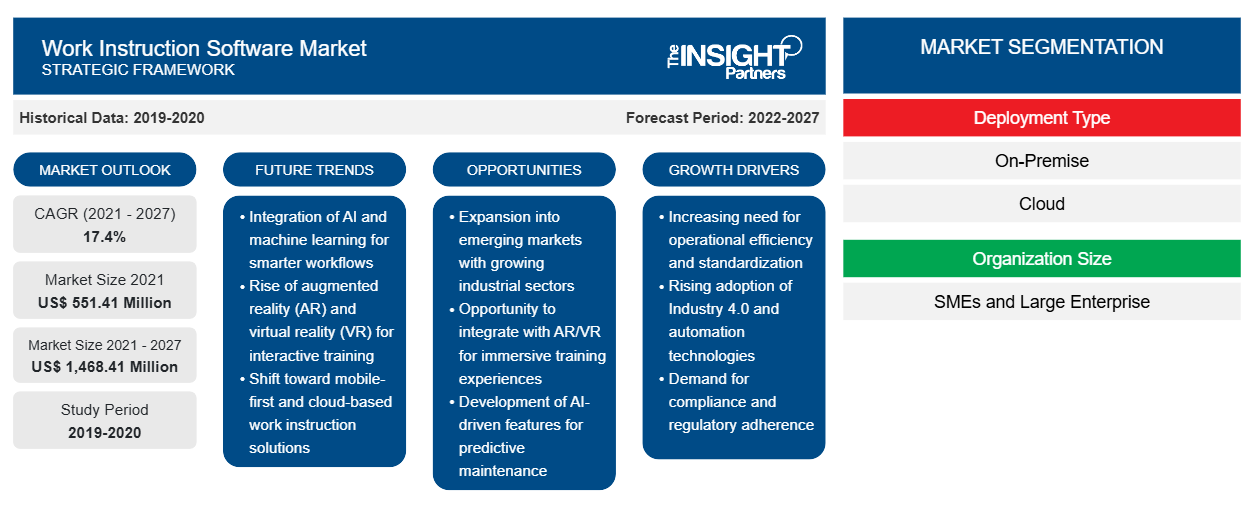Der Markt für Arbeitsanweisungssoftware soll von 551,41 Millionen US-Dollar im Jahr 2021 auf 1.468,41 Millionen US-Dollar im Jahr 2027 wachsen. Im Prognosezeitraum von 2020 bis 2027 soll der Markt für Arbeitsanweisungssoftware mit einer durchschnittlichen jährlichen Wachstumsrate (CAGR) von 17,4 % wachsen.
Der Schlüsselfaktor, der den Markt antreibt, sind die sich ständig ändernden Geschäfts- und Produktionskomplexitäten. Die Einführung gemischter Produktionsmodelle zur Steigerung der gesamten Produktionsproduktivität des Unternehmens schafft den Bedarf an verbesserter Schulung und Entwicklung der Mitarbeiter. Dies fördert somit die Einführung von Arbeitsanweisungssoftware im gesamten Fertigungssektor. Der Bedarf an Mitarbeiterschulungen zur Verbesserung der Produktivität führt zur Einführung technologisch fortschrittlicher Lösungen in den Unternehmen. Die zunehmende Komplexität der Arbeitsprozesse in Branchen wie Fertigung, Automobilindustrie, Gesundheitswesen und Einzelhandel erhöht die Nachfrage nach Arbeitsanweisungen für Mitarbeiter und Arbeiter, damit diese ihre Aufgaben unabhängig und effizient ausführen können. Beispielsweise bietet Augmentir, Inc. eine auf künstlicher Intelligenz basierende Plattform für vernetzte Arbeitskräfte an, die Mitarbeitern mit digitalen Arbeitsabläufen und Fernanleitung während des gesamten Arbeitsprozesses hilft.
Angesichts der weltweiten Ausbreitung der COVID-19-Pandemie wird deutlich, dass sich nur wenige ihrem Einfluss entziehen können, was alle Branchen vor erhebliche Herausforderungen stellt. Die Software wird jedoch hauptsächlich im Fertigungssektor eingesetzt, wo sie zur Schulung der Mitarbeiter in Bezug auf die Funktionsweise bestimmter Maschinen eingesetzt wird. Daher wird erwartet, dass sich die Schließung aller Produktionsstätten sowohl in Industrie- als auch in Entwicklungsländern negativ auf das Wachstum des Marktes für Arbeitsanweisungssoftware auswirken wird .
Basierend auf dem Bereitstellungstyp wird die Arbeitsanweisungssoftware in On-Premise und Cloud unterteilt. Die Cloud-basierten Lösungen werden im Prognosezeitraum voraussichtlich die höchste durchschnittliche jährliche Wachstumsrate aufweisen. Darüber hinaus wird der Markt für Arbeitsanweisungssoftware basierend auf der Unternehmensgröße in KMU und Großunternehmen unterteilt. Großunternehmen hatten den größten Marktanteil. Der globale Markt für Arbeitsanweisungssoftware wurde in fünf Hauptregionen unterteilt: Nordamerika, Europa, APAC, MEA und SAM.
Passen Sie diesen Bericht Ihren Anforderungen an
Sie erhalten kostenlose Anpassungen an jedem Bericht, einschließlich Teilen dieses Berichts oder einer Analyse auf Länderebene, eines Excel-Datenpakets sowie tolle Angebote und Rabatte für Start-ups und Universitäten.
- Holen Sie sich die wichtigsten Markttrends aus diesem Bericht.Dieses KOSTENLOSE Beispiel umfasst eine Datenanalyse von Markttrends bis hin zu Schätzungen und Prognosen.
Einblicke in den Markt für Arbeitsanweisungssoftware
Veränderung der Arbeitskultur im gesamten Unternehmen
Der steigende Trend zu Bring Your Own Device (BYOD) in Verbindung mit einer Kultur der Fernarbeit in Unternehmen, insbesondere in großen Unternehmen, schafft den Bedarf an Arbeitsanweisungslösungen, um einen reibungslosen Ablauf im Unternehmen sicherzustellen. Die flexible Arbeitskultur in den Unternehmen hat dazu geführt, dass Mitarbeiter nicht in den Büros anwesend sind, was zu Störungen im Arbeitsablauf führt, insbesondere bei Mitarbeitern auf niedrigerer Ebene, die kontinuierliche Unterstützung benötigen, um zu lernen und Aufgaben auszuführen, um Ziele zu erreichen. Die Integration von Arbeitsanweisungslösungen in Unternehmen ermöglicht es Arbeitgebern, alle Mitarbeiter zu schulen, ohne dass die physische Barriere die Produktionseffizienz beeinträchtigt.
Bereitstellungstyp-basierte Markteinblicke
Basierend auf der Bereitstellungsart ist der globale Markt für Arbeitsanweisungssoftware in Cloud-basierte und On-Premise-Bereitstellung unterteilt. Die Cloud-basierte Arbeitsanweisungssoftware erfreut sich im Vergleich zur On-Premise-Arbeitsanweisungssoftware einer hohen Nachfrage. Das Cloud-Segment generiert den Großteil der Nachfrage, da es vergleichsweise kostengünstig ist und über eine starke Netzwerkinfrastruktur in entwickelten Ländern verfügt. Darüber hinaus konzentrieren sich die Anbieter von Cloud-basierter Arbeitsanweisungssoftware stark auf die Entwicklung eines hochrangigen Sicherheitspatches, um das Risiko von Cyberangriffen auszuschließen. Dieser Faktor erzeugt auch eine erhebliche Nachfrage seitens der Endbenutzer und treibt so den Markt für Arbeitsanweisungssoftware an.
Markteinblicke basierend auf der Unternehmensgröße
Basierend auf der Unternehmensgröße ist der Markt für Arbeitsanweisungssoftware in KMU und Großunternehmen segmentiert. Die zunehmenden Investitionen in die Fertigungsinfrastruktur in Industrie- und Entwicklungsländern treiben die Nachfrage nach Arbeitsanweisungssoftware bei KMU erheblich an.
Akteure auf dem Markt für Arbeitsanweisungssoftware konzentrieren sich auf Strategien wie Marktinitiativen, Akquisitionen und Produkteinführungen, um ihre Position auf dem Markt für Arbeitsanweisungssoftware zu behaupten. Einige Entwicklungen der wichtigsten Akteure auf dem Markt für Arbeitsanweisungssoftware sind:
Im April 2020 ging SwipeGuide eine Partnerschaft mit XMReality ein, um digitale Arbeitsanweisungen per Remote-Support bereitzustellen.
Im Oktober 2019 implementierte Georg Fischer Signet AssemblyX von Lifecycle Technology Ltd. zur Arbeitsinstrumentierung.
Regionale Einblicke in den Markt für Arbeitsanweisungssoftware
Die regionalen Trends und Faktoren, die den Markt für Arbeitsanweisungssoftware während des gesamten Prognosezeitraums beeinflussen, wurden von den Analysten von Insight Partners ausführlich erläutert. In diesem Abschnitt werden auch die Marktsegmente und die Geografie von Arbeitsanweisungssoftware in Nordamerika, Europa, im asiatisch-pazifischen Raum, im Nahen Osten und Afrika sowie in Süd- und Mittelamerika erörtert.

- Erhalten Sie regionale Daten zum Markt für Arbeitsanweisungssoftware
Umfang des Marktberichts zur Arbeitsanweisungssoftware
| Berichtsattribut | Details |
|---|---|
| Marktgröße im Jahr 2021 | 551,41 Millionen US-Dollar |
| Marktgröße bis 2027 | 1.468,41 Millionen US-Dollar |
| Globale CAGR (2021 - 2027) | 17,4 % |
| Historische Daten | 2019-2020 |
| Prognosezeitraum | 2022–2027 |
| Abgedeckte Segmente | Nach Bereitstellungstyp
|
| Abgedeckte Regionen und Länder | Nordamerika
|
| Marktführer und wichtige Unternehmensprofile |
|
Dichte der Marktteilnehmer für Arbeitsanweisungssoftware: Die Auswirkungen auf die Geschäftsdynamik verstehen
Der Markt für Arbeitsanweisungssoftware wächst rasant, angetrieben durch die steigende Nachfrage der Endnutzer aufgrund von Faktoren wie sich entwickelnden Verbraucherpräferenzen, technologischen Fortschritten und einem größeren Bewusstsein für die Vorteile des Produkts. Mit steigender Nachfrage erweitern Unternehmen ihr Angebot, entwickeln Innovationen, um die Bedürfnisse der Verbraucher zu erfüllen, und nutzen neue Trends, was das Marktwachstum weiter ankurbelt.
Die Marktteilnehmerdichte bezieht sich auf die Verteilung von Firmen oder Unternehmen, die in einem bestimmten Markt oder einer bestimmten Branche tätig sind. Sie gibt an, wie viele Wettbewerber (Marktteilnehmer) in einem bestimmten Marktraum im Verhältnis zu seiner Größe oder seinem gesamten Marktwert präsent sind.
Die wichtigsten auf dem Markt für Arbeitsanweisungssoftware tätigen Unternehmen sind:
- Lifecycle Technology GmbH
- Livepro Wissensmanagement
- SwipeGuide
- ScreenSteps, LLC
- Visual Knowledge Share Ltd.
Haftungsausschluss : Die oben aufgeführten Unternehmen sind nicht in einer bestimmten Reihenfolge aufgeführt.

- Überblick über die wichtigsten Akteure auf dem Markt für Arbeitsanweisungssoftware
Markt für Arbeitsanweisungssoftware – nach Bereitstellungstyp
- Wolke
- Vor Ort
Markt für Arbeitsanweisungssoftware – nach Unternehmensgröße
- Große Unternehmen
- KMU
Markt für Arbeitsanweisungssoftware – nach Geografie
- Nordamerika
- UNS
- Kanada
- Mexiko
- Europa
- Frankreich
- Deutschland
- Russland
- Vereinigtes Königreich
- Italien
- Restliches Europa
- Asien-Pazifik (APAC)
- China
- Indien
- Japan
- Australien
- Südkorea
- Restlicher Asien-Pazifik-Raum
- MEA
- Saudi-Arabien
- Vereinigte Arabische Emirate
- Südafrika
- Rest von MEA
- SAM
- Brasilien
- Argentinien
- Rest von SAM
Markt für Arbeitsanweisungssoftware – Firmenprofile
- Dozuki
- eFlex-Systeme
- Hexagon AB
- Lifecycle Technology GmbH
- Livepro Wissensmanagement
- Optel Software
- ScreenSteps, LLC
- SwipeGuide
- Visual Knowledge Share Ltd.
- Zaptic
- Historische Analyse (2 Jahre), Basisjahr, Prognose (7 Jahre) mit CAGR
- PEST- und SWOT-Analyse
- Marktgröße Wert/Volumen – Global, Regional, Land
- Branchen- und Wettbewerbslandschaft
- Excel-Datensatz
Aktuelle Berichte
Verwandte Berichte
Erfahrungsberichte
Grund zum Kauf
- Fundierte Entscheidungsfindung
- Marktdynamik verstehen
- Wettbewerbsanalyse
- Kundeneinblicke
- Marktprognosen
- Risikominimierung
- Strategische Planung
- Investitionsbegründung
- Identifizierung neuer Märkte
- Verbesserung von Marketingstrategien
- Steigerung der Betriebseffizienz
- Anpassung an regulatorische Trends





















 Kostenlose Probe anfordern für - Markt für Arbeitsanweisungssoftware
Kostenlose Probe anfordern für - Markt für Arbeitsanweisungssoftware